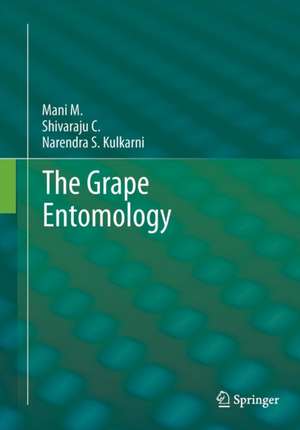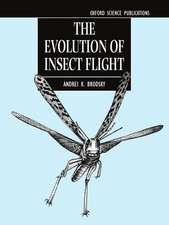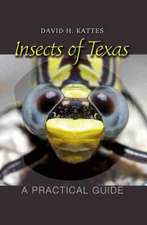The Grape Entomology
Autor M. Mani, C. Shivaraju, Narendra S. Kulkarnien Limba Engleză Paperback – oct 2016
| Toate formatele și edițiile | Preț | Express |
|---|---|---|
| Paperback (1) | 943.88 lei 6-8 săpt. | |
| Springer India – oct 2016 | 943.88 lei 6-8 săpt. | |
| Hardback (1) | 950.52 lei 6-8 săpt. | |
| Springer India – 16 dec 2013 | 950.52 lei 6-8 săpt. |
Preț: 943.88 lei
Preț vechi: 1151.07 lei
-18% Nou
Puncte Express: 1416
Preț estimativ în valută:
180.67€ • 196.31$ • 151.86£
180.67€ • 196.31$ • 151.86£
Carte tipărită la comandă
Livrare economică 21 aprilie-05 mai
Preluare comenzi: 021 569.72.76
Specificații
ISBN-13: 9788132235101
ISBN-10: 813223510X
Pagini: 224
Ilustrații: XXII, 202 p. 115 illus., 113 illus. in color.
Dimensiuni: 178 x 254 x 12 mm
Greutate: 0.4 kg
Ediția:Softcover reprint of the original 1st ed. 2014
Editura: Springer India
Colecția Springer
Locul publicării:New Delhi, India
ISBN-10: 813223510X
Pagini: 224
Ilustrații: XXII, 202 p. 115 illus., 113 illus. in color.
Dimensiuni: 178 x 254 x 12 mm
Greutate: 0.4 kg
Ediția:Softcover reprint of the original 1st ed. 2014
Editura: Springer India
Colecția Springer
Locul publicării:New Delhi, India
Cuprins
1. Introduction.- 2. Grape cultivation.- 3. Pests.- 4. Pesticides used in grape pest management.- 5. Biopesticides and biocontrol agents used in vineyards.- 6. Pesticide residue management in grapes.- 7. Annexure.- 8 General precautions.- 6. Index.
Notă biografică
Dr. M. Mani is an agricultural scientist with over 35 years of R&D experience in the entomological research. He has served in Indian Council of Agricultural Research and Tamil Nadu Agricultural University. His focal subject is pest control in horticultural crops including grapes. Presently, he is an Emeritus professor of ICAR, New Delhi. He has received numerous awards including life time achievement award for his contribution to the research in horticulture entomology.
Dr. Narendra Kulkarni has worked as an agricultural scientist at NRC Grapes, Pune, for 6 years and contributed significantly in developing Integrated Pest Management on grapes. He was also associated with the APEDA sponsored project entitled “Regulation of export of fresh grapes from India through monitoring of pesticide residues”. He has been awarded with “Abhinav Gourav” citation and gold medal for outstanding contribution to the grape growers of Maharashtra. Presently, he is a Senior Scientist at IGFRI, RRS, Dharwad.
Dr. C. Shivaraju has extensively worked on insects infesting several agricultural and horticultural crops in Indian Institute of Horticultural Research and National Bureau of Agriculturally Important Insects both located at Bangalore. He has significantly contributed to the research on eucalyptus and papaya pest management.
Dr. Narendra Kulkarni has worked as an agricultural scientist at NRC Grapes, Pune, for 6 years and contributed significantly in developing Integrated Pest Management on grapes. He was also associated with the APEDA sponsored project entitled “Regulation of export of fresh grapes from India through monitoring of pesticide residues”. He has been awarded with “Abhinav Gourav” citation and gold medal for outstanding contribution to the grape growers of Maharashtra. Presently, he is a Senior Scientist at IGFRI, RRS, Dharwad.
Dr. C. Shivaraju has extensively worked on insects infesting several agricultural and horticultural crops in Indian Institute of Horticultural Research and National Bureau of Agriculturally Important Insects both located at Bangalore. He has significantly contributed to the research on eucalyptus and papaya pest management.
Textul de pe ultima copertă
Intensive and extensive cultivation of grapes (Vitis vinifera L.) leads to serious pest problem in vineyards in major grape growing areas of the world. Climatic conditions in India are favorable for high production of table and wine grapes, and thus also for incidence of variety of pests. These include the sucking insect pests namely thrips, hoppers, mealybugs etc., and beetle pests like stem borer, stem girdler, flea beetles, chafer beetles, shot hole borer and several lepidopteron, mites, nematodes and vertebrate pests. Pests of grapes in other countries relevant to Indian conditions are also dealt herewith since they may get introduced in India in future. Up to date information on biology, damage, seasonal development, management practices of the pests are covered in this book. Some of the pest management practices followed in other countries are also given, which will be useful to Indian conditions. Pesticide residue is a serious problem both for export and internal market in grapes. Guideline for pesticide residue management in grapes is also given in this book. The authors have tried to accommodate almost all the important information generated on the grape pests up to 2012. A complete list of grape pests (except disease) occurring in different grape growing regions of the world is also covered in this book which will be ready reckoner for the grape workers. The authors sincerely hope that this book will provide useful information to many entomologists, students working on grapes and the grape growers in the country. It is a pleasure to thank all those people who gave help, suggestions and encouragement in the preparation of our book “The Grape Entomology”.
Caracteristici
The scope of the book covers the main insects and mite pests of viticulture Color illustrations provide insights into the pests and their biology Contains reviews of current pest management practices as well as new directions for future research?









